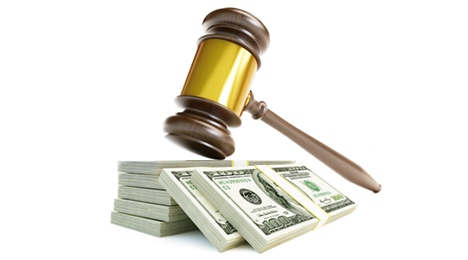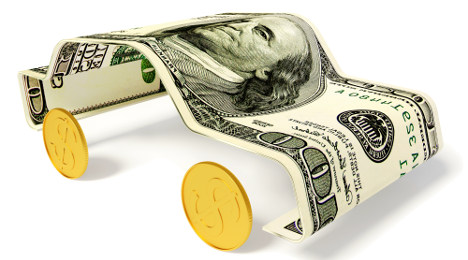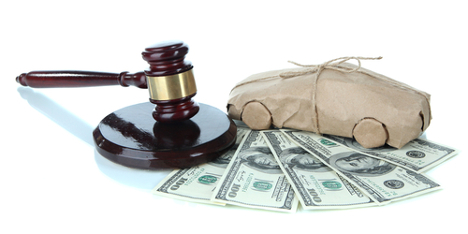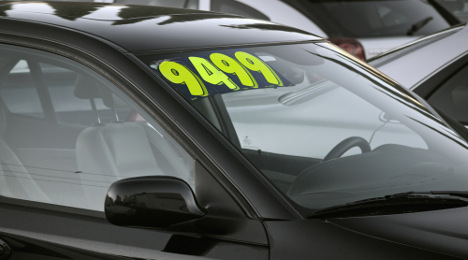Certainly automakers and dealerships want buyers to pay a premium retail price for a certified pre-owned vehicle stemming from the reconditioning and other costs associated with the unit. But are consumers ready to pony up the extra cash or willing to finance that additional cost?
The latest survey from NADA Used Car Guide gave OEMs and managers some tangible data.
As a part of NADA Used Car Guide’s 2016 Certified Pre-Owned Consumer survey, consumers were asked to select a dollar amount they would be willing to pay for a CPO vehicle above and beyond a non-CPO used vehicle. The question was prefaced with a series of common CPO program benefits — comprehensive inspection and reconditioning requirements, an extended bumper-to -bumper warranty, etc. — to help respondents assign value.
Taken as a collective, analysts found the largest chunk of respondents (39 percent) were willing to pay up to $1,000 more for a CPO vehicle versus a non-certified used vehicle.
However, analysts noticed a sizable 31 percent of participants stated they weren’t willing to pay any premium for a CPO vehicle.
The remaining portion of responses were spread between a $1,000 to $2,000 premium to a more than $4,000 premium.
As might be expected, CPO premium results were much different when the data is grouped by the likelihood of a future CPO purchase. Of those stating they were, “likely” or “extremely likely” to consider purchasing a CPO vehicle, 44 percent said they would pay up to $1,000 more versus a non-certified vehicle. Just 11 percent said they would pay nothing.
In addition, 22 percent stated they would pay $1,000 to $2,000.
Although the sample size is somewhat small — 181 participants to be exact — NADA UCG indicated 36 percent of luxury vehicle consumers said they would pay a premium of up to $1,000, while 32 percent would pay $1,000 to $2,000.
Just 8 percent of self-proclaimed luxury buyers wouldn’t pay any premium.
“Given that NADA Used Car Guide mainstream and luxury brand CPO premiums currently average $1,190 and $2,160, respectively, consumer feedback among those willing to buy a CPO vehicle is generally in line with where premiums are actually transacting,” analysts said in their August Perspectives that was dedicated to summarizing the survey data.
Of those claiming neutral intent toward a CPO purchase, NADA UCG pointed out the vast majority (44 percent) once again were willing to spend up to $1,000. In contrast, a sizable 28 percent weren’t willing to pay anything above and beyond the cost of a typical used vehicle.
“Not surprisingly,” according to analysts, premiums were much lower for individuals claiming they were either unlikely or extremely unlikely to consider a future CPO purchase, with nearly 60 percent stating they would pay nothing.
“It should be noted that premium results based on purchase likelihood were generally similar when viewed by age, gender and level of CPO familiarity,” NADA Used Car Guide said.
In light of that cost premium information — along with what Auto Remarketing previously reported about CPO awareness — NADA Used Car Guide tried to explain what it all means for dealers and automakers. The summations came from two regular participants who are coming back to this year’s Used Car Week, which runs from Nov. 14 to 18 at the Red Rock Resort and Casino in Las Vegas.
Jonathan Banks, executive analyst at NADA Used Car Guide said, “What the data tells us is that there is an opportunity for the industry to make consumers more aware of the availability of manufacturer certified pre-owned vehicle programs.”
Larry Dixon, senior manager of market intelligence at NADA Used Car Guide added, “There is also an opportunity to educate consumers on the benefits of CPO vehicle ownership and why it may be worth paying more over a non-certified used vehicle.”
While it’s not exactly the case where crickets are chirping in the lanes, Black Book representatives from several parts of the country noticed soft activity at the auction.
Along with recapping the year-over-year differences in full-size pickup prices, this week’s Black Book Market Insights report revealed what dealers are experiencing when making their trips to secure inventory.
In Texas, Black Book’s representative said, “The market has been dropping the last several weeks and continues to do so in this area.”
Two different accounts from Tennessee relayed similar sentiments as one Black Book lane watcher pointed out, “Full-size pickups are in demand but overall, sales are slow,” while the other added, “Buyers say retail is slow in this particular area.”
Down in Florida, the story was, “The market trend in this area is steady to slow,” according to Black Book personnel.
And to the North, it wasn’t much better as Black Book’s representative in Pennsylvania shared, “This week was the poorest buyer response I have seen for this time of year with perfect weather.” In Illinois, the situation was slightly more positive, but Black Book reported back saying, “Prices remain stable at this location even with low attendance.”
Out West, the hammer wasn’t coming down as often in Washington: “It was a below average sale this week with prices down on most models.”
Getting into more detail about prices, Black Book editors decided to shine a spotlight on the full-size pickup segment, which has shown just a slight depreciation curve over the last 16 weeks. Editors explained that what’s interesting here is that a year ago during the same time, this segment showed stronger retention with an increase in value in the same time period.
“Luxury car values decreased at a steeper rate than mainstream brand cars, while pickup trucks continue to show retention strength. Several locations reported slower sales and low attendance at auctions,” said Black Book senior vice president of automotive valuation and analytics Anil Goyal, who will be making multiple appearances during Used Car Week at the Red Rock Resort and Casino in Las Vegas from Nov. 14 to 18.
Volume-weighted, Black Book indicated overall car values decreased by 0.53 percent last week. This reading is higher than the average depreciation rate of 0.43 percent seen in the previous four weeks.
As Goyal previously mentioned, luxury cars led the decline by 0.85 percent, followed by the near-luxury car and sub-compact car segments dropping by 0.79 percent and 0.77 percent, respectively.
Volume-weighted, Black Book determined overall truck values decreased by 0.37 percent last week. This movement is similar to the average depreciation rate of 0.35 percent seen in the previous four weeks.
Pickups and full-size crossovers/SUVs retained good values, according to editors.
RVI Group analysts noticed more than half of the 19 vehicle segments they track for the Market Update posted a month-over-month increase in residual values during June.
Leading this group with a rise of 1.9 percent were two vehicle segments that can get a lot of work during the summertime — full-size pickups and sports cars. Not far off that pace, RVI Group put the month-over-month residual uptick for minivans at 1.8 percent and luxury coupes at 1.6 percent.
Overall, RVI Group noticed used-vehicle prices increased in June.
The RVI Used Vehicle Price Index (Real) increased by 0.3 percent in June when compared to May. When compared to June of last year, the index fell by 3.5 percent.
RVI’s Used Vehicle Price Index (Nominal) increased by 0.5 percent in June when compared to May. When compared to last June, the index decreased by 1.6 percent.
RVI Group also mentioned in its latest Market Update that new-vehicle prices softened by 0.4 percent year-over-year in June. Analysts added that new-model transaction prices on a seasonally adjusted basis ticked 0.1 percent lower in June on a sequential basis.
Finally, while recapping data from the U.S. Department of Energy, RVI Group pointed out that June gas prices jumped 4.1 percent compared to the previous month. But looking at pump prices year-over-year, the price of gas is 14.5 percent lower.
RVI Group’s Rene Abdalah will again be a part of the National Remarketing Conference at Used Car Week, adding to a panel discussion about wholesale prices. Used Car Week begins Nov. 14 at the Red Rock Resort and Casino in Las Vegas.
While wholesale prices seem to be moving at a “normal rate,” Black Book representatives in the lanes this past week noticed dealers didn’t come to auction as much as summertime heat became entrenched from coast to coast.
This week’s Black Book Market Insights report relayed the sentiment from Missouri that indicated, “Consignment and attendance were both below normal at this week’s auction.”
A similar scene unfolded in Arizona as Black Book mentioned, “Attendance was low today but the market seems steady. Also, rental cars did very well today.”
In Tennessee, the story went like this: “The market is still good here, but buyers say sales are down a little compared to previous weeks.”
Up in Washington, Black Book’s lane watcher added, “Prices were down on most units today with pickups still in fair demand.”
And with the last full week of July straight ahead, what Black Book found in Texas might be an indication of what’s going to happen as August approaches.
“The market trend was much better this week, but many are saying they expect more and more no-sales in the upcoming weeks,” the Lone Star State representative said.
Moving along to the data segment of Black Book’s latest report, editors said car and truck segments depreciated at nearly the same percentage this past week. Also, they pointed out that cars saw heavier depreciation at the same time last year, while the opposite was noticed for trucks.
“The used-vehicle values continue to depreciate at a normal rate at this time of the year, with truck segments continuing to perform better than car segments,” said Anil Goyal, Black Book’s senior vice president of automotive valuation and analytics.
Volume-weighted, Black Book indicated overall car values decreased 0.39 percent last week. For comparison, last year the overall depreciation rate was 0.43 percent.
The compact car segment checked in with the highest weekly depreciation rate at 0.69 percent. The luxury segment declined 0.52 percent, followed closely by sub-compact and mid-size segments at 0.46 percent.
On the truck side, overall volume-weighted values decreased 0.37 percent last week. A year ago, the overall truck depreciation rate came in at 0.34 percent.
Editors noted the compact luxury and full-size luxury CXU/SUV segments posted the highest weekly depreciation rates at 0.96 percent and 0.92 percent, respectively. Black Book added this movement also was the highest weekly decline this year for these segments.
NADA Used Car Guide reports that its seasonally adjusted used-vehicle price index at the midyear mark was 3.7 percent below last year’s six-month average.
And the rate of depreciation is increasing: Used-vehicle prices were 12 percent lower through June relative to all of last year. In the same period last year, that figure was 9 percent lower than full-year 2014. .
According to the latest Guidelines report, subcompact car prices fell the most through June, down by an average of 19 percent. Compact car depreciation reached 15 percent; midsize and large cars were down by just over 13 percent. Trucks and utilities saw milder declines: large pickups were down less than 7 percent, while large utility and midsize pickups prices were down by 5.5 percent.
Depreciation across luxury segments ranged from 11.4 percent for luxury large utilities to just below 15 percent for luxury large cars.
The one segment that saw an improvement in depreciation relative to last year was large utility. Prices fell by 7.1 percent over the first half of 2015, but only fell 5.4 percent in the first half this year.
Mainstream car depreciation was roughly 4 percentage points higher through this June, while mainstream truck depreciation was 3 points worse. Luxury car and truck depreciation was 1.5 and 2.7 points higher, respectively.
“Used-vehicle prices are clearly, but not unexpectedly, on a downward trend,” Larry Dixon, senior manager for market intelligence for NADA Used Car Guide, said via email. “This comes following years of exceptional strength. But as the strength exhibited over the past several years was due to falling used-vehicle supply, the softness we’re currently witnessing is largely due to increasing supply.”
That rising supply, he said, is attributable to the recovery of new-vehicle sales and a massive increase in leasing since 2013. “Manufacturer incentives are also taking a toll on used-vehicle prices,” he said. “Incentive spending is as high as it’s ever been and with new-vehicle sales appearing to plateau, it’s likely it will move even higher.”
What happened in June
Wholesale prices of vehicles up to 8 years old fell by 2.4 percent in June compared to May — the steepest monthly decline thus far in 2016, but in line with expectations for the month.
As such, NADA Used Car Guide’s used-vehicle price index moved only slightly, falling by 0.2 percent to 119.9.
Looking at individual segments, prices of mainstream used cars continued their near-industry high rate of decline in June. Subcompact car prices fell by an average rate of $455 over the month, which translates to a 4.5 percent decline from May. This was the steepest loss for the segment since last September’s nearly 6 percent drop.
Losses for midsize and large cars were high but not atypical for this time of year, with depreciation for each at 3.2 percent. Compact car depreciation was in line with last June at 3 percent.
Midsize and large pickup prices were relatively unchanged for the third straight month; prices for both slipped by a combined average of 0.6 percent in June. Prices for other mainstream truck segments fell between 1 percent (large utility) and 2.2 percent (compact utility).
Luxury cars saw the steepest price drop last month, with prices declining 4.7 percent in June after falling only 0.3 percent in May. June’s figure was nearly 3 percentage points worse than the segment’s five-year average for the period. Monthly average depreciation for the four months prior to June was 1 percent.
Among other segments, luxury compact utility and luxury large utility prices fell by 2.6 percent and 3 percent, respectively. Luxury midsize car prices fell 2.3 percent, and luxury midsize utility and luxury compact car prices were down by 1.6 percent.
Forecast for July and beyond
NADA Used Car Guide predicts that prices of vehicles up to 8 years old will fall by 2.5 percent to 3 percent in July when compared to June. This is somewhat higher than the 2-percent decline averaged for the month over the past five years.
Subcompacts are expected to fall by 3 percent to 3.5 percent in July, while compact, midsize and large car prices are expected to fall by an average of 3 percent. Prices for these segments fell at similar rates last July, with the exception being subcompacts, which were down more than 4 percent last year.
Other segments are expected to fall by 2.5 percent or less.
Depreciation is expected to pick up as the market enters what is typically considered the softest part of the year. Used vehicle prices are expected to fall by about 3 percent in August and 3.5 percent in September (last year, those numbers were 2 percent and 3.4 percent, respectively).
NADA Used Car Guide’s full-year forecast now has prices of used vehicles up to 8 years old falling by an average of less than 5 percent on an index basis from last year — an improvement over the previous outlook of a 5 percent to 6 percent decline.
Dixon said this is based on relatively solid market performance over the past two months as opposed to an expected improvement in fundamentals moving forward.
“Moving forward, NADA Used Car Guide expects to see used prices continue to soften as supply and incentives move steadily higher. The positive, other factors affecting used-vehicle prices, namely job growth, consumer sentiment, overall economic activity, credit conditions, etc., remain relatively good. In short, we’re transitioning from a period dictated by extraordinary factors to one more in line with the ‘status quo,’” Dixon explained.
Along with some specifics as to what dealers wanted coming down the lanes, this week’s Black Book Market Insights report showed depreciation across the board for all car and truck segments.
Editors put particular emphasis on trucks and small crossovers. They indicated vehicles in these segments faced the heaviest price drops this past week with compact vans added into the mix, too.
“Weekly depreciation rates have been fairly consistent since Memorial Day with cars at a cumulative adjustment of 2.7 percent, a 35-percent higher rate of decline compared to trucks at 2.0 percent,” said Anil Goyal, Black Book’s senior vice president of automotive valuation and analytics.
Volume-weighted, editors indicated overall car values decreased 0.37 percent last week. That’s the lowest overall weekly deprecation rate in the past six weeks.
Black Book noticed full-size and midsize car segments received the highest weekly depreciation rates at 0.66 percent and 0.54 percent, respectively. In fact, the full-size segment registered its highest weekly depreciation rate this year.
Volume-weighted, editors found that overall truck values decreased 0.30 percent last week. A year ago, the decline came in at 0.17 percent.
Black Book analysis showed the sub-compact luxury crossover segment turned in the highest weekly deprecation rate at 1 percent. Three segments followed closely with 0.79 percent declines; that group included sub-compact crossovers and compact luxury crossovers as well as compact vans.
So in light of the prices movements, what are dealers seeking to fill their inventories? Black Book’s representative in Florida reported, “Buyers continuously looking for low mileage, clean history units in this location.”
Perhaps those kinds of units were what brought out the hammer quickly in Michigan as Black Book reported, “A very big auction today. Bidding was active and the sales percentages were high.”
Two recaps from Tennessee showed varied wholesale activity as one representative indicated, “Prices were strong here today with full-size pickup trucks leading the way,” while another also stationed in the Volunteer State added, “A lot of no-sales in the highline lanes today.”
Up in Pennsylvania, Black Book spotted some soft activity, too, as its representative said, “Seems to be fewer cars and more trucks and SUVs on the lanes these days.”
Finally out West, Black Book’s representative in Washington noticed, “Prices were down a little on most models today, but still a good auction.”
Trucks literally are carrying the pricing load, according to ADESA Analytical Services’ monthly analysis of wholesale used vehicle prices by vehicle model class.
ADESA’s Tom Kontos reported on Tuesday that wholesale used-vehicle prices in June averaged $10,556, which was down 1.5 percent compared to May but up 3.3 percent relative to June of last year. Kontos pointed out that car model classes again took the bigger month-over-month hit and were down on a year-over-year basis while truck prices climbed.
“Average wholesale values fell again on a month-over-month basis in June, but they remain up on a year-over-year basis largely because of the continued price strength of trucks,” Kontos said as a part of his Kontos Kommentary he distributes each month.
“A portion of the month-over-month price decline can be explained by the usual falloff in prices from May to June, typifying the transition from the strong spring/tax season to the less robust summer months,” he continued. “However, incentive activity, which has been relatively benign, may be on the rise, as manufacturers look to boost waning new vehicle sales — a pattern that bears watching.
“In the meantime, retail used vehicle sales were strong in June, which once again provided demand-side support for wholesale values receiving downward pressure from supply growth,” Kontos went on to say.
Data from the National Automobile Dealers Association showed a 5.3-percent year-over-year increase in retail used-vehicle sales by franchised dealers and a 9.1-percent increase for independent stores in June. “Both were up significantly up month-over-month,” Kontos added.
As previously reported by Auto Remarketing, Kontos also cited figures from Autodata Corp. that highlighted June certified pre-owned sales ticked up 0.8 percent month-over-month and 5.0 percent year-over-year.
That sales activity pushed average wholesale prices for used vehicles remarketed by manufacturers 5.7 percent higher month-over-month and 2.0 percent year-over-year.
Kontos noted prices for fleet/lease consignors softened 1.1 percent sequentially but edged 0.7 percent higher annually. He also mentioned dealer consignors registered a 1.1-percent price decrease versus May but a 3.6-percent increase relative to June of last year.
Kontos went into more detail about wholesale activity in Canada in the video that can be viewed at the top of this page or here.
ADESA Wholesale Used-Vehicle Price Trends
| |
Average |
Price |
($/Unit) |
Latest |
Month Versus |
| |
June 2016 |
May 2016 |
June 2015 |
Prior Month |
Prior Year |
| |
|
|
|
|
|
| Total All Vehicles |
$10,556 |
$10,718 |
$10,215 |
-1.5% |
3.3% |
| |
|
|
|
|
|
| Total Cars |
$8,556 |
$8,952 |
$9,901 |
-4.3% |
-3.8% |
| Compact Car |
$6,468 |
$6,835 |
$6,765 |
-5.4% |
-4.4% |
| Midsize Car |
$7,659 |
$8,045 |
$7,690 |
-4.8% |
-0.4% |
| Full-size Car |
$7,354 |
$7,864 |
$7,820 |
-6.5% |
-6.0% |
| Luxury Car |
$13,087 |
$13,740 |
$13,881 |
-4.7% |
-5.7% |
| Sporty Car |
$14,294 |
$14,207 |
$13,813 |
0.6% |
3.5% |
| |
|
|
|
|
|
| Total Trucks |
$12,573 |
$12,673 |
$11,675 |
-0.8% |
7.7% |
| Minivan |
$7,823 |
$7,932 |
$7,353 |
-1.4% |
6.4% |
| Full-size Van |
$12,483 |
$13,361 |
$13,022 |
-6.6% |
-4.1% |
| Compact SUV/CUV |
$10,868 |
$10,851 |
$10,414 |
0.2% |
4.4% |
| Midsize SUV/CUV |
$11,101 |
$11,484 |
$10,123 |
-3.3% |
9.7% |
| Full-size SUV/CUV |
$13,639 |
$13,502 |
$11,770 |
1.0% |
15.9% |
| Luxury SUV/CUV |
$18,850 |
$19,175 |
$18,655 |
-1.7% |
1.0% |
| Compact Pickup |
$8,699 |
$9,283 |
$8,162 |
-6.3% |
6.6% |
| Full-size Pickup |
$15,797 |
$15,857 |
$14,420 |
-0.4% |
9.6% |
Source: ADESA Analytical Services. May revised.
While circling back as to how current wholesale price levels might impact movements during the second half of the year, Cox Automotive chief economist Tom Webb acknowledged scores of vehicles currently are sitting at auction because they have an open recall and cannot be sold. The situation might become even more obvious depending on how many current Volkswagen diesel owners opt to dispose of their units as a part of the automaker’s ongoing rectification of what’s been dubbed in some circles as “Dieselgate.”
Of course, there are vehicles from a wide array of badges that can’t go down the lanes, which Webb indicated is “obviously extremely unfortunate because we’ve had some very good pricing in the market now.
“When they’re available for sale, you’re not only fighting the seasonal trend but also probably a cyclical trend downward, too. It’s been extremely unfortunate, and I know everyone would rather have those units available, but that’s simply not possible,” Webb continued when he hosted his quarterly conference call soon after the latest Manheim Used Vehicle Value Index was released.
Unlike the VW situation where the OEM and federal regulators continue to collaborate on an approved repair, other open recalls are not triggering as much of a public outcry but still are causing issues for auctions, consignors and dealers.
“For many of them, the parts are not readily available so they are not going to come back into the market very quickly,” Webb said. “There is some concern that if you were able to wave a magic wand and fix all of these open recall units and push them on the market that would have a depressing impact on price. But the fact of the matter is there is no magic wand and they will come back into the market at a relative steady rate."
As previously reported by Auto Remarketing, Manheim said that wholesale prices are now at their highest level in more than four years after rising every month in the second quarter. Webb attempted to project what the current level might do to price movements later in the year, especially in autumn as off-rental activity ticks higher in conjunction with off-lease volume that’s already on the rise.
“I would say frankly I’m a little surprised by the strength in wholesale prices so far this year,” Webb said after the latest Manheim data indicated the Manheim Index now is only 1.3 percent away from the record high reached in May 2011.
“As anticipated, the volumes have been quite strong and they pretty much have been in line with what we’ve expected,” he continued. “There are of course some units sitting at auction that you can’t sell because of recalls. One could argue that might have had a positive impact in terms of prices, but that’s arguable.
“Almost everyone is expecting that prices will decline. To get to what we’ve expected for the year, we’re going to have to have a steeper fall off,” Webb went on to say.
As parts for recalls become available, it means the service bays at franchised dealerships are humming. Webb pointed out what that situation means for auctions beyond just bringing down the sales hammer each week.
“The amount of reconditioning work that is done varies quite a bit by consignor and the types of vehicle segments that they’re selling,” Webb said. “Given the shifts we’ve had, that favors the recon environment from our standpoint. Off-lease units that get into the open auction process are probably going to have more recon attached if they get to the physical auction.
“But in terms of the practices of the individual consignors, I don’t think they have substantially changed,” he continued.
“Where we have seen some changes is there is probably better utilization where buyers who are buying units and doing post-recon work at our facilities,” Webb went on to say. "Some of that has been because we’ve been better at marketing it as well as related to the recalls because the dealers’ service facilities are backed up with their own recall activity. Therefore, to the extent they can get the work done at auction, they avail themselves for that opportunity.”
Also of note, Webb quickly touched on conversion rates and what they might do to the wholesale market going forward.
“The conversion rates at auction were not very good in March and early April, but they’re now back to normal or even a little bit higher than normal, which is a good thing,” he said.
The average price of a used vehicle for model years 2011-2015 fell by 1.7 percent during June, following 0.5 percent depreciation in May — typical of seasonal patterns, according to Black Book.
Cars in June saw noticeably higher depreciation (2.2 percent) than trucks, which saw 1.3-percent depreciation for the month. All vehicles are averaging a 12-month depreciation change of 15.4 percent, in line with pre-recession rates.
“The overall monthly depreciation rate is showing typical seasonal patterns as we approach the mid-summer part of the calendar,” said Anil Goyal, senior vice president of automotive valuation and analytics for Black Book.
“Furthermore, in looking at the heaviest of depreciation in recent months, it’s interesting to see a few luxury categories listed among the smaller-vehicle segments.”
Subcompact luxury utilities saw the highest depreciation during June at 3.5 percent. Vehicles in this segment include the Audi Q3, BMW X1, Mercedes-Benz G Class, and the Mini Cooper Countrymen. Units in this segment finished the month with an average price of $17,998, a 19.9-percent decline from year-ago levels.
Small pickups saw the best retention during the month at 0.1 percent, the only segment to see a change for the positive. Vehicles in this segment include the Chevrolet Colorado, Dodge Dakota, Ford Explorer Sport Trac, and the Toyota Tacoma. Units in this segment finished the month with an average price of $19,601, a downward change of 6.9 percent from a year ago (best 12-month retention).
Four segments saw greater than 5 percent depreciation over the last three months: prestige luxury cars (down 5.6 percent), compact vans (5.5 percent), subcompact cars (5.4 percent) and luxury cars (5.1 percent).
Two more small-vehicle segments are close behind: compact luxury utilities (down 4.6 percent) and compact cars (down 4.6 percent).
On a year-over-year basis, compact vans showed the highest depreciation at 23.4 percent, while car and truck prices fell by 18.4 percent and 12.8 percent, respectively. Besides small pickups (down 6.9 percent), full-size crossover SUVs were the only other segment to see less than 10 percent depreciation year-over-year at (8.9 percent).
After rising every month in the second quarter, Manheim said on Friday that wholesale prices are now at their highest level in more than four years.
Wholesale used vehicle prices (on a mix-, mileage- and seasonally adjusted basis) increased for the third consecutive month in June, resulting in a Manheim Index reading of 126.2. Manheim explained that the latest wholesale price reading now is only 1.3 percent away from the record high reached in May 2011.
“There is still no doubt that the long-term trend for wholesale pricing is down, not up. So every modest step up now should be taken advantage of — and appreciated, as each is likely raising the floor to which prices will fall in this cycle,” Cox Automotive chief economist Tom Webb said in commentary that accompanied the latest Manheim Index update.
Webb also mentioned that unadjusted prices remain high, adding, “Naturally, unadjusted prices continued to rise faster than the Manheim Index, as the sales composition shifts toward more lower-mileage units and a higher commercial consignment share.”
Manheim determined that prices for pickups generated much of the most recent monthly rise. Pickup prices jumped 8.1 percent in June — the highest figure among four other major vehicle segments Manheim tracks that generated upticks last month.
Also moving higher in June were prices for vans (up 3.5 percent), SUV/CUV (up 1.3 percent), luxury cars (up 1.0 percent) and midsize cars (up 0.2 percent).
Only the 2.4 percent price softening by compact cars kept it from being a clean sweep of increases within the vehicle segment of the Manheim Index.
“All of the strength in wholesale pricing remains concentrated in pickups, vans and certain sports cars — the same segments that are enjoying the strongest increases in average new-vehicle transaction price,” Webb said. “Wholesale pricing for all other market classes is flat to down.
“Within price tiers, our analysis was mostly non-definitive, and not correlated with volume shifts,” he continued. “There was some additional weakness in the lower-middle price tier ($7,000 to $8,000 at wholesale), which could suggest some negative shifts in the subprime financing environment.”
Off-rental unit update
Manheim indicated lower mileage and better mix drove rental risk prices higher in June.
Webb noted a straight average of auction prices for rental risk units sold in June jumped nearly 18 percent from a year ago. Last June, the average mileage on rental risk units was a record-high 51,200 miles. This year, it fell to 38,500 miles — the lowest since December 2013.
“June’s mix of crossovers and vans was significantly higher, while the share of rental risk unit sales accounted for by midsize cars was down. Rental units being sold at auction this June were also in better condition,” Webb said.
“Rental risk auction prices, adjusted for broad changes in mix and mileage (but not condition), were flat in June relative to a year ago,” he continued. “They were up 2.2 percent from May, on significantly lower volume.”












